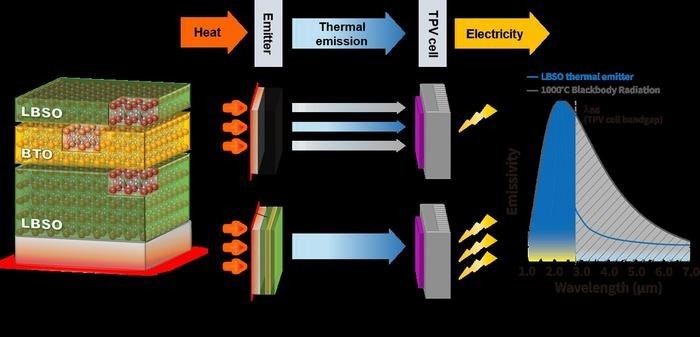All objects that have temperature release thermal radiation, which is electromagnetic radiation. The solar radiation spectrum is the most representative type of thermal radiation since it enters the Earth and contributes to the greenhouse effect.
 This diagram illustrates the effects of applying an LBSO thermal emitter to TPV technology. In the case of a typical blackbody, when it absorbs heat, it emits radiant energy over a very broad wavelength range. However, this results in the emission of radiation energy at wavelengths that cannot be utilized by TPV cells, leading to reduced efficiency. By applying LBSO thermal emitters, it can selectively emit heat in the wavelength range where the TPV cells have the highest efficiency, increasing the overall energy generation efficiency. Image Credit: Korea Institute of Science and Technology (KIST)
This diagram illustrates the effects of applying an LBSO thermal emitter to TPV technology. In the case of a typical blackbody, when it absorbs heat, it emits radiant energy over a very broad wavelength range. However, this results in the emission of radiation energy at wavelengths that cannot be utilized by TPV cells, leading to reduced efficiency. By applying LBSO thermal emitters, it can selectively emit heat in the wavelength range where the TPV cells have the highest efficiency, increasing the overall energy generation efficiency. Image Credit: Korea Institute of Science and Technology (KIST)
The cost of producing electricity can be decreased by managing and harnessing the thermal radiation energy released by solar power, thermal power generation, and residual heat in industrial locations.
As a result, applications for radiation spectrum regulating technologies in energy production, cooling, and heat dissipation are growing in popularity. Radiation spectrum management technology has traditionally been applied in a wide range of environmental settings. Still, recently, materials resistant to extreme circumstances have become more and more important, including space, aviation, and TPV systems.
The Nanophotonics Research Center team, under the direction of Senior Researcher Jongbum Kim, has created a refractory material that can regulate the thermal radiation spectrum while preserving optical qualities, even at temperatures as high as 1,000 °C in an air atmosphere under intense UV light. This development was announced by the Korea Institute of Science and Technology (KIST).
Using pulsed laser deposition, the group created lanthanum-doped barium stannate oxide ("LBSO") as a nanoscale thin film without lattice strain. The LBSO material did not oxidize readily at high temperatures, in contrast to traditional refractory conducting materials like tungsten, nickel, and titanium nitride.
It was able to withstand exposure to temperatures as high as 1,000 °C and 9 MW/cm2 of intense ultraviolet radiation. The multilayer structure was found to be as stable to heat and light as the single layer thin film, confirming its applicability to TPV power generation technology.
The researchers then used LBSO to fabricate a thermal emitter based on this multilayer structure with high spectral selectivity in the infrared band. Without the need for additional precautions to keep it from oxidizing when in contact with air, the LBSO material permits thermal radiation to be delivered to the PV cell.
As an alternative to solar and wind renewable energy, whose electricity production varies depending on the weather, eco-friendly thermoelectric power generation technology that uses radiant energy emitted by the Sun and high-temperature environments to generate electricity is gaining attention. LBSO will contribute to addressing to climate change and the energy crisis by accelerating the commercialization of thermoelectric power generation.
Jongbum Kim, Senior Researcher, Nanophotonics Research Center, Korea Institute of Science and Technology (KIST)
Because LBSO is extremely resistant to ultraviolet radiation, the researchers anticipate that it will find application not only in the recycling of waste heat from industrial equipment and thermoelectric power generation technology but also in the management of heat produced by strong sunlight absorption and exposure to harsh environments like space and aviation.
The study was funded by the Ministry of Science and ICT (Minister Jong-ho Lee) through the Information and Communication Technology Development Project and Standard Development Support Project, and the KIST Future Source Research Project.
Journal Reference:
Kim, H., et.al., (2023). Perovskite Lanthanum‐Doped Barium Stannate: A Refractory Near‐Zero‐Index Material for High‐Temperature Energy Harvesting Systems. Advanced Science. doi.org/10.1002/advs.202302410